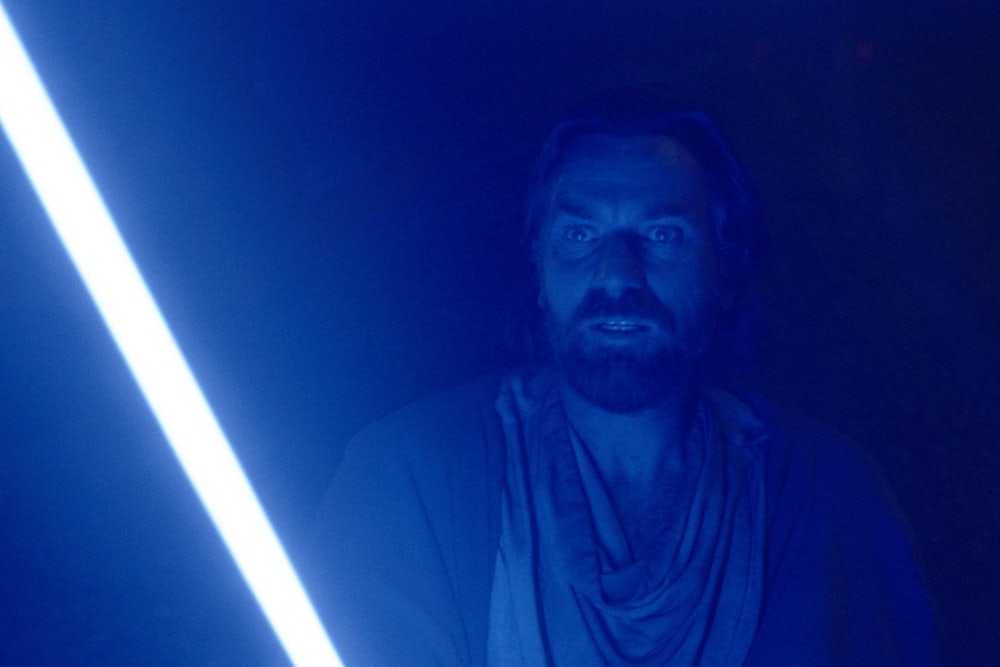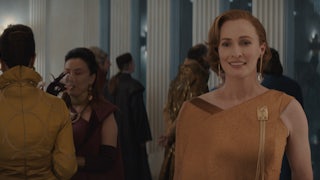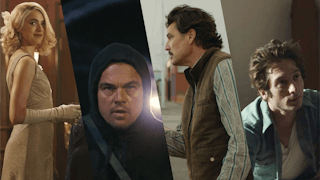I fell in love with Star Wars in 2007. Entranced by the action, the romance, the grand scale of a saga that encompassed the fate of a galaxy, I watched one movie on repeat. That movie, the movie that hooked me, was not the celebrated original, A New Hope, first released in 1977 and later rebranded as Episode IV. It was not Episode V: The Empire Strikes Back or Episode VI: Return of the Jedi, the other two films in the classic original trilogy. A trio of so-called prequels, widely considered to be inferior to the original series, appeared in 1999, 2002, and 2005; my favorite was not Episode I: The Phantom Menace or Episode III: Revenge of the Sith, the better two of that bunch. No, the movie I loved was Episode II: Attack of the Clones, which chronicles the awkward travails of Anakin Skywalker, the sulky Jedi-to-be who will eventually become Darth Vader. If you’re unfamiliar, Attack of the Clones sees Anakin fall in love, fight with his mentor, Obi-Wan Kenobi, and brutally murder an entire village. It is generally thought to be among the worst Star Wars films. On internet rankings, you can usually find it hovering somewhere near the bottom.
In my defense, I was in seventh grade. Replaying the DVD so many times that it scratched and skipped, I had no idea of the conventional wisdom about what was and wasn’t considered “good” Star Wars. I just knew what I liked. Like many children of the 1990s—younger millennials and older members of Generation Z—the prequels were my Star Wars movies. As an adult, I can appreciate their depictions of the corrosive effects of endless war on democracy, how an authoritarian government can take hold under the guise of populism, while at the same time recognizing the unwieldy dialogue, the tacky CGI, the uncomfortable racial stereotypes. But neither the sophisticated themes nor the unmistakable flaws registered with me as a child or punctured the awe and excitement I felt upon watching the movies: the same joy that young Gen Xers experienced watching the original trilogy. Even as I have revised my personal rankings to acknowledge the superiority of the originals, I still enjoy the prequels. And when I watch a Star Wars show or movie now that reawakens that old sense of wonder, it’s like I’m 12 years old again, jumping up and down on our well-worn couch during a climactic lightsaber battle. When I’m let down by Star Wars, as is far more often the case, I wonder if a few moments of joy are worth the frustration. This is the fate of the Star Wars fan: to be forever trying to recapture the initial discovery, the inaugural thrill, and yet forever braced for disappointment.
You can forgive me, then, for my excitement about Obi-Wan Kenobi, the new series from Disney+ that stages a reunion between Anakin, played by Hayden Christensen, and Obi-Wan Kenobi, played by Ewan McGregor. The prequel trilogy had tracked the dissolution of that relationship and prepared the way for a showdown between the pair in A New Hope, when Darth Vader defeats Obi-Wan in battle. (The relationship between Anakin and Obi-Wan was further explored in the excellent 2000s-era animated series The Clone Wars, in which Anakin was voiced by Matt Lanter and Obi-Wan by James Arnold Taylor.) The climactic battle between master and apprentice at the end of Revenge of the Sith, after Anakin has joined the Dark Side in a futile attempt to save his pregnant wife from dying, ends when Obi-Wan defeats Anakin, cutting off his limbs and leaving him to burn on the banks of a river of lava. The scene has been memed and memed again, making it easy to forget how moving it is when viewed in context: the crack in Obi-Wan’s voice as he tells Anakin he once loved him; Anakin’s fury as he writhes in agony. A grievously injured Anakin is deposited in Darth Vader’s famous suit, and Obi-Wan retreats into self-imposed exile. They are destined not to meet again for nearly 20 years, until their battle in A New Hope.
That is, until the executives of Lucasfilm decided that it might be pretty cool if Darth Vader and Obi-Wan met up sometime in the interim.
Set 10 years after the events of Revenge of the Sith, the new Obi-Wan Kenobi show takes place roughly at the midpoint between that movie and A New Hope, during the lost period when Obi-Wan is ensconced on the arid planet Tatooine, watching over protagonist-in-waiting Luke Skywalker, Anakin’s son. Obi-Wan is not the suave, confident Jedi of the former film, nor the wise and wizened mentor of the latter, as portrayed by Alec Guiness. He is a hermit in the desert: Obi-Wan the Obscure. In the first episode, frequent close-ups of McGregor’s face, craggier than when he last played Obi-Wan more than a decade and a half ago, are balanced by wide shots emphasizing the emptiness of his existence, the loneliness of his solitary life. “The time of the Jedi is over,” Obi-Wan tells another character in the premiere. “Let it go.”
This line should be taken with a grain of salt—or of sand, as the first episode is largely set on Tatooine’s desertscape. Viewers know that the Jedi will triumph a few short years after this show is set. Neither is the time of the Jedi finished in our world. Over Memorial Day weekend, at the annual Star Wars Celebration in California, a plethora of new content was promised: new series starring characters we have seen before, like Ahsoka, a fan favorite of The Clone Wars show, and Cassian Andor, a freedom fighter depicted in 2016’s Rogue One; a prequel show set a hundred years before the events of The Phantom Menace, the first prequel movie; a new animated series; and the long-awaited sequel of a beloved video game.
These shows join a surfeit of existing Star Wars TV. On Disney+ alone, there’s the live-action The Mandalorian (decent) and The Book of Boba Fett (not so much). Then there are the animated Disney+ shows, such as The Bad Batch, which was meh even setting aside the controversy touched off by allegations that characters’ skin tones had been lightened, and the seventh season of The Clone Wars, the last four installments of which I would consider one of my favorite Star Wars movies if you were allowed to count TV episodes in your rankings. And don’t forget about the animated shows that aired on Disney XD and Disney Channel, such as the superb Star Wars: Rebels. (I’m aware that there are yet other Star Wars shows I haven’t mentioned, so don’t @ me.)
Every Star Wars show that appears on Disney+ is, of course, retreading ground plowed by earlier content. Even the most dedicated of viewers can acknowledge the recent series, including Obi-Wan Kenobi, as an exquisitely produced cash cow that aims to gain new subscribers for the streaming service by capitalizing on fans’ love for earlier movies and shows, particularly their attachment to certain familiar characters. It follows, then, that the cast of Obi-Wan Kenobi is stacked with competent actors, several of whom are reprising roles from earlier films, though the most intriguing character of the first few episodes is a new one: Reva, an “inquisitor” tasked with capturing lost Jedi and obsessed with finding Obi-Wan. Played with crackling menace by Moses Ingram, Reva steals every scene she is in. But the twists and turns of the first two episodes of Obi-Wan Kenobi are mere window dressing to the primary conflict of the six-episode series. In the final few seconds of the second episode, the true narrative purpose of the show is teased, as McGregor’s eyes widen and his breath shallows in a convincing portrayal of a man on the verge of a panic attack. Obi-Wan is learning what he never imagined could be true: that his former apprentice Anakin did not die. Long live Darth Vader.
The possibility of a rematch between Anakin and Obi-Wan is, at first thought, alluring. By the third episode, the impending conflict between Obi-Wan and Darth Vader has escalated from a simmer to a boil, as we witness the villainy of Vader and the grief inherent in a reunion between betrayer and betrayed. (Who betrayed whom is, of course, a matter of perspective.) “What have you become?” Obi-Wan asks Vader during their confrontation in the third episode. Christensen, wearing the famous suit, imbues Vader with an intimidating physicality made more chilling by James Earl Jones’s indelible voice work. “I am what you made me,” Vader replies. He is both the boy Obi-Wan trained and the man he destroyed.
But the episode nonetheless raises questions about how Obi-Wan Kenobi fits into the larger story and illuminates the difficulty, for the writers, of negotiating an ever-expanding narrative universe without compromising the material that exists. When Obi-Wan and Vader met in A New Hope, Vader said: “When I left you, I was but the learner. Now, I am the master.” Can that quote still be accurate, can the stakes of that final battle between the two still be as powerful, if another meeting was jammed in between movies?
Recent Star Wars series on Disney+ have contorted themselves trying to integrate beloved characters. In a stirring scene in the final episode of the second season of The Mandalorian, a digitally de-aged Mark Hamill appeared as Luke Skywalker. But the effect was somewhat dimmed by his extended cameo in The Book of Boba Fett, when the deep-faked nature of Hamill’s character distracted from the scene, which itself was an unnecessary diversion from the ostensible plot of the show. The younger version of Leia, Luke’s twin sister, makes a sprightly appearance in Obi-Wan Kenobi, thankfully played by a real actor, a delightful Vivien Lyra Blair. They may be doing it for the fans—but, as it may go without saying, relying on beloved figures to trigger viewers’ nostalgia does not a good series make.
Of course, in an important sense, it doesn’t matter whether these shows are good: The content will keep on coming, and it will always find viewers. Obi-Wan Kenobi is a redemption story for its titular character, yes, but also for those who grew up loving the prequels, spurned for so long by the larger Star Wars fandom. Perhaps, the show teases, it will recapture the best moments of those films: the pleasure of seeing McGregor on-screen once again as Obi-Wan, the delicious terror of hearing Darth Vader’s booming baritone, the catharsis of witnessing the two meet again. Or perhaps the pathos of the reunion will ultimately feel hollow, unearned. This is the good fortune of the executives responsible for creating more Star Wars: Even unsuccessful shows elicit fans’ involvement. After all, you have to watch a show to declare it a disappointment. In a sense, the disappointment is its own kind of satisfaction. Saying “This doesn’t measure up” is a way of underlining the power of the initial primal encounter, whatever it was. And there is always the promise, the hope, that the next one will be different. When this show ends, we, like Obi-Wan, will be left wandering in the desert, waiting for the story to begin again.






